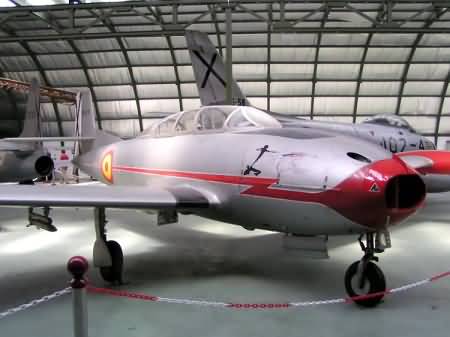05/15/2007. As after WW II the design and production of aircraft were prohibited
in Germany, several German aircraft designers/manufacturers looked
abroad for work in their specific professions. Willy Messerschmitt
opened an office in Spain, named "Officina Technica Prof.
Messerschmitt". In December 1951 Hispano Aviación SA and
Messerschmitt signed a contract covering the design and construction
of an operational piston-engined trainer, an advanced jet-trainer,
and a supersonic fighter. On January 1, 1952, Prof. Julius Krauss and
his team started work at Hispano, Seville, Spain, on the HA-100,
HA-200 and HA-300 respectively.
The two-seat advanced flying and armament trainer HA-200 was the
first Spanish jet-powered aircraft. It had parts common with the
HA-100 Triana, including wings and tail plane. The tandem cockpit was
pressurized and it was driven by two 882 lb (400 kg) st Turboméca
Marboré II turbojets. Two prototypes HA-200-R1 were built and
registered as EC-AMM and EC-ANN. The first flight was made by Hispano
test pilot Fernando de Juan Valiente at Seville on August 12, 1955;
the second prototype flew for the first time on January 11, 1957.
Later the two prototypes received the military designation XE.14
Saeta and the s/n XE.14-1 and XE.14-2 respectively, the latter is
pictured above.
Ten pre-production aircraft (designated E.14) were ordered by the
Spanish AF, 5 HA-200-As, and 5 HA-200-Bs. The HA-200-A was fitted
with two 0.278 in (7 mm) machine guns in the nose and on four
strong-points under the wings Oerlikon air-to-ground rockets and four
110 lb (50 kg) bombs could be carried. The pre-production HA-100-A
flew for the first time on June 6, 1960. After evaluation the Spanish
AF ordered 30 production examples, the first flew October 11, 1962.
Similar to the HA-200-A, the HA-200-B differed in equipment, for
instance, it was fitted with one 0.787 in (20 mm) cannon in the nose.
The pre-production HA-100-B flew for the first time on July 21, 1960.
After evaluation these five were sold to Egypt, renamed Al Kahira
(Cairo) they were used as pattern aircraft as the Egyptian company
Helwan was to build 90 aircraft under license for the Egyptian AF
between 1962 and 1965.
A second production batch was ordered by the Spanish AF, basically
similar to the HA-200-A, but with refinements, including strengthened
strong-points, and hydraulic plate brakes. These 55 HA-200-Ds were
delivered from mid-1965.
However, the first HA-200-D was retained by Hispano to be converted
to the prototype HA-200-E Super Saeta. That version was powered by
two 1,058 lb (480 kg) st Turboméca Marboré VI turbojets, and had
redesigned air intakes, stronger landing gear and updated avionics.
This version did not enter production but was developed into the
HA-220.
The HA-220 Super Saeta was a single-seat ground attack version
powered by the Marboré VI turbojets. It was fitted with two 0.303 in
(7.7 mm) machine guns in the nose, and four 551 lb (250 kg)
strong-points under the wings and two 375 lb (170 kg) strong-points
under the fuselage. Also it carried an extra fuel tank in place of
the second seat, and it was fitted with light armour protection and
appropriate avionics for the ground attack role. The Spanish AF
ordered 25 aircraft under the designation C.10 (later redesignated
A.10), these were delivered between 1971 and 1977.
Hispano merged into CASA in 1972, hence the Super Saeta is sometimes
designated as CASA HA-220.
